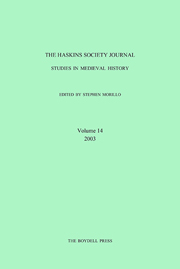Book contents
- Frontmatter
- Contents
- List of Illustrations
- Editorial Note
- Abbreviations
- 1 Even the Devil (Sometimes) has Feelings: Emotional Communities in the Early Middle Ages
- 2 Alcuin, Willibrord, and the Cultivation of Faith
- 3 Henry Loyn Memorial Lecture: English Identity from Bede to the Millennium
- 4 The ‘Farm of One Night’ and the Organisation of Royal Estates in Late Anglo-Saxon Wessex
- 5 Changing Fortunes: Edwardian Anglo-Jewry and their Credit Operations in Late Thirteenth-Century England
- 6 Forty Acres and a Mule: the Mechanics of English Settlement in Northeast Wales after the Edwardian Conquest
- 7 Consanguinity and the Saint-Aubin Genealogies
- 8 Widows, Religious Patronage and Family Identity: Some Cases from Twelfth-Century Yorkshire
- 9 Desecration and Consecration in Norman Capua, 1062–1122: Contesting Sacred Space during the Gregorian Reforms
- 10 From Ego to Imago: Mediation and Agency in Medieval France (1000–1250)
10 - From Ego to Imago: Mediation and Agency in Medieval France (1000–1250)
Published online by Cambridge University Press: 05 September 2014
- Frontmatter
- Contents
- List of Illustrations
- Editorial Note
- Abbreviations
- 1 Even the Devil (Sometimes) has Feelings: Emotional Communities in the Early Middle Ages
- 2 Alcuin, Willibrord, and the Cultivation of Faith
- 3 Henry Loyn Memorial Lecture: English Identity from Bede to the Millennium
- 4 The ‘Farm of One Night’ and the Organisation of Royal Estates in Late Anglo-Saxon Wessex
- 5 Changing Fortunes: Edwardian Anglo-Jewry and their Credit Operations in Late Thirteenth-Century England
- 6 Forty Acres and a Mule: the Mechanics of English Settlement in Northeast Wales after the Edwardian Conquest
- 7 Consanguinity and the Saint-Aubin Genealogies
- 8 Widows, Religious Patronage and Family Identity: Some Cases from Twelfth-Century Yorkshire
- 9 Desecration and Consecration in Norman Capua, 1062–1122: Contesting Sacred Space during the Gregorian Reforms
- 10 From Ego to Imago: Mediation and Agency in Medieval France (1000–1250)
Summary
In 600, Gregory the Great (d. 604) wrote to the iconoclastic bishop of Marseille, Serenus, that images (picturae) in churches allow those who do not know letters (litteras) to learn something of sacred history (historia) by seeing (visione) and reading (lectione) on the walls what they are unable to grasp in written texts. In his letter, Gregory gave much evidence of his belief in the supremacy of the written word over the painted image. He repeatedly cast the non-literate as ignorant simpletons (ignorantes, idiotae) and virtual pagans (gentes). Though recognizing the image to be functionally analogous to script when the capacity for reading Scripture was wanting, he nevertheless denied concrete images any of the sacrality that imbued the Bible. He held that the contemplation of religious images might lead to the adoration of God, but that the power to do so was not inherent in the image itself. For Gregory, the effect of an image was limited by what corporeal vision could offer, a mere sensual grasp of material forms. It was the historia painted upon religious images, it was the vision of sacred history (visio historiae, visio rei gestae) which engaged spiritual seeing and feelings (ardor compunctionis), and led to proper adoration, that of the Triune God. Centuries later, Guillaume Durand, bishop of Mende, wrote in the Rationale divinorum officiorum (1285–1292) that ‘images seem better to be able to move the spirit than scripture, which is why, in the Church, we show more reverence to images than to books’.
- Type
- Chapter
- Information
- The Haskins Society Journal 142003. Studies in Medieval History, pp. 151 - 173Publisher: Boydell & BrewerPrint publication year: 2005



